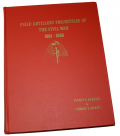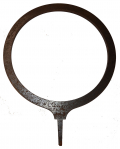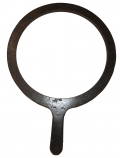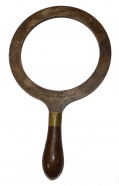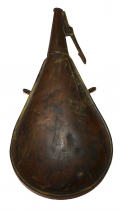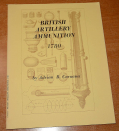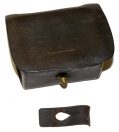site search
online catalog
Artillery
Showing 41 to 60 out of 63
RARE, EXCAVATED, CONFEDERATE 3” ARCHER BOLT WITH SABOT -- ANTIETAM
Here is an excavated, Confederate 3” field artillery projectile commonly referred to as an Archer Bolt. The design was likely produced by Dr. Robert Archer a partner of Joseph Anderson, the… (2024-1378). Learn More »
CIVIL WAR “SPINNER” QUILL PRIMERS FOR NAVAL CANNONS
These Naval cannon primers are constructed using fowl quills; less likely to corrode around salt water. These are percussion, not friction primers. In use, these were ignited by the blow from a… (2024-1521). Learn More »
BOOK – FIELD ARTILLERY PROJECTILES OF THE CIVIL WAR 1861-1865 BY KERKSIS & DICKEY
First edition, hardcover signed by both authors. Limited to 500 numbered copies, this is #303. Text clean and unmarked; 307 pages, 8.5” x 11”. The binding is tight and square. Cover is bright and… (2024-1206). Learn More »
RELIC -- US NAVAL WATERCAP FUSE DATED 1862
Excavated naval watercap fuse dated 1862 and in very good condition. This brass fuse is made of brass with flange on top, with threaded portion and tapered body. This type of fuse was utilized by the… (84-84). Learn More »
$125.00
SOLD
1857 US NAVY YARD WASHINGTON MARKED 10-INCH SHOT/SHELL GAUGE
This is a nice pre-Civil War US Navy shot or shell gauge dated 1857. The wood handle is missing, but iron tang and ring are intact, showing dark, with some light pitting, but good markings on the base… (490-6808). Learn More »
11-INCH SHOT/SHELL GAUGE
These simple iron ring gauges allowed for quick inspection and sorting of shot and shell by size, something of critical importance to a gun crew and a large task given the huge stacks of cannon balls… (490-6807). Learn More »
POSTWAR US NAVY YARD WASHINGTON ARTILLERY SHOTSHELL GAUGE
This shell gauge still has its wood handle with brass ferrule and is clearly marked on the base of the ring: “ORD. DEPT. U.S. N.Y.W. / 1867 / G.B. / [anchor]” on one side, and “STANDARD / SMALL… (490-6806). Learn More »
RARE USN GOSPORT NAVY YARD PRIMING FLASK
Gosport Shipyard was the original name of the facility in Portsmouth, Virginia, that was founded in 1767, passed into the hands of Virginia in the Revolution, was leased from that state by the U.S.… (490-6824). Learn More »
NICE U.S. ARTILLERY FUSE POUCH
The leather is in nice, smooth condition with a pleasing dark brown tone. The latch tab is stitched to the underside of the flap. This tab remains unbroken but well worn. The outer flap is only… (490-6254). Learn More »
THEFT REPORTED AT AUTUMN GETTYSBURG SHOW
A vendor at the Autumn Gettysburg Civil War show held at the Allstar Events Complex on Oct. 28-29 reported that a Maryland sword belt plate valued at $3500 was stolen from a display case on Sunday…. Learn More »
BOOKLET ON 18TH CENTURY BRITISH ARTILLERY AMMUNITION FROM THE LIBRARY OF THE LATE DEAN S. THOMAS
The title of this pamphlet is “BRITISH ARTILLERY AMMUNITION 1780” by Adrian B. Caruana and published by Museum Restoration Service of Bloomfield, Ontario, Canada in 1979. Yellow heavy stock paper… (236-416). Learn More »
U.S. NAVY FRICTION PRIMER BOX
Small leather box to hold friction primers were carried on the belt (past terminology designated this type box as a Navy fuse box). The box is relatively square in shape to accommodate the shape of… (490-5342). Learn More »
CONFEDERATE ARTILLERY FUSE POUCH WITH LEAD FINIAL
Brown leather Confederate artillery fuse pouch is in good condition. This is the leather pouch that went on the side of the Confederate artilleryman. It held his paper time fuses for firing the… (381-20). Learn More »
$3,150.00
Originally $3,950.00
CIVIL WAR QUILL PRIMERS FOR NAVAL CANNONS
These Naval cannon primers are constructed using fowl quills; less likely to corrode around salt water. These are percussion, not friction primers. In use, these were ignited by the blow from a… (490-2928). Learn More »
CONFEDERATE TEN SECOND PAPER TIME FUSE
This ten-second fuse originated from the magazine at Fort Jackson, Louisiana. Fuse was recovered by a Union soldier in 1862, who packaged several in a box and documented it by writing the information… (R21944). Learn More »
$200.00
Originally $295.00
CONFEDERATE TEN SECOND PAPER TIME FUSE
This ten-second fuse originated from the magazine at Fort Jackson, Louisiana. Fuse was recovered by a Union soldier in 1862, who packaged several in a box and documented it by writing the information… (R21942). Learn More »
$200.00
Originally $295.00
COPPER SABOT FROM 3” MULLANE SHELL FROM GETTYSBURG
Found in Gettysburg after the battle. From the Soldier’s National Museum auction of 2014. Copper sabot stripped from a Confederate 3” Mullane artillery shell. The sabot is a round disk with a… (224-514). Learn More »
MEXICAN WAR TO CIVIL WAR PORTFIRE STOCK
Before the introduction of the friction primer it was necessary to keep a ready flame handy for the lighting of linstocks carrying slow match to fire the gun or to fire it directly and even later they… (1158-07). Learn More »
RARE 10” MORTAR SHELL (FRENCH & INDIAN OR REVOLUTIONARY WAR) FROM FORT TICONDEROGA MUSEUM COLLECTION
This early mortar shell was once housed in the Fort Ticonderoga Museum collection. It is an excavated 10” mortar shell in relic condition. The iron body of the shell is in solid condition with… (1117-26). Learn More »
COMPLETE PACKAGE OF TAYLOR FUSE IGNITERS
Here is a paper-wrapped stack of tin fuse igniters for Taylor’s time fuse. The whole stack is wrapped in tan packing paper. The packing paper is water damaged, missing a few fragments, and quite… (727-50). Learn More »
Showing 41 to 60 out of 63
Most Popular
Historical Firearms Stolen From The National Civil War Museum In Harrisburg, Pa »
Theft From Gravesite Of Gen. John Reynolds »
Selection Of Unframed Prints By Don Troiani »
Fine Condition Brass Infantry Bugle Insignia »
British Imported, Confederate Used Bayonet »
Scarce New Model 1865 Sharps Still In Percussion Near Factory New »
featured item
HISTORICAL FIREARMS STOLEN FROM THE NATIONAL CIVIL WAR MUSEUM IN HARRISBURG, PA
Please click on the photograph above to view a flyer containing information regarding a Model 1860 Henry Rifle and pair of cased presentation Colt Revolvers identified to Secretary of War Simon Cameron which were stolen from the museum on February… . Learn More »
site search
Upcoming Events
May 16 - 18: N-SSA Spring Nationals, Fort Shenandoah, Winchester, VA Learn More »





